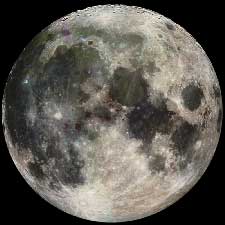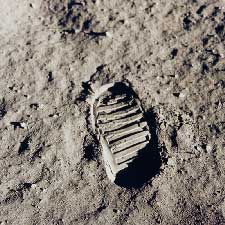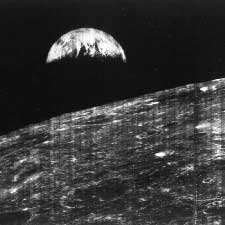The Moon
When we refer to “the Moon” we mean Earth’s moon. All of the other planetary moons in the solar system have their own specific names. The reason that we don’t have a specific name for the Moon is because it was the first moon ever discovered. At the time we didn’t know whether there were any other moons in existence, when it became apparent that there were many more moons in addition to the Earth’s Moon we started to give them all names. It was Galileo Galilei that discovered four moons orbiting Jupiter in 1610 so after that we set about giving moons different names.
The Moon is the second brightest object in the sky after the Sun. Technically, Venus is brighter than the Moon, but because the Moon is so much closer to the Earth it looks brighter to the naked eye.
It is thought that the Moon was formed billions of years ago when a planet collided with the Earth and the resulting debris formed into our Moon.
About the Moon’s orbit
The Moon is a celestial body that orbits the Earth in a synchronous rotation. This means the Moon travels around the Earth in a full circle but it only ever shows the same side to the Earth. It does this because it rotates on its own axis in exactly the same time that it takes to orbit the Earth. The Moon takes 27 Earth days to complete a full orbit of the Earth and the Moon’s distance from the Earth during orbit is around 384,000 kilometres.
The Moon’s effect on our tides
The Moon orbits Earth so closely that the gravitational pull from the Moon affects our oceans’ tides. The gravitational pull from the Moon causes two bulges in the Earth – one on the side that faces the Moon and one on the opposite side. Due to the fact that the Earth spins 27 times faster than the Moon moves around the planet, the bulges are dragged along the Earth’s surface which cause high and low tides depending on what side of the planet you are on.
Lunar eclipse
A lunar eclipse occurs when the orbit of the Moon takes it directly behind the Earth and the Earth completely blocks the Sun so there is no sunlight reaching the Moon whatsoever. The full eclipse can only happen when there is a full Moon and all three celestial bodies – the Sun, Moon and Earth are all directly in a straight line. Once the three bodies begin to fall out of alignment it will become a partial or penumbral eclipse which means only an area of the Moon is now covered.
There are usually two or three lunar eclipses per year (there can never be more than three in one year) and the eclipse lasts for a few hours so provided you are on the right side of the Earth for the particular eclipse you should be able to see an eclipse sometime soon!
Moon Facts
The Moon has a very weak atmosphere called an exosphere.
The diameter of the Moon is roughly one quarter the diameter of the Earth, but the mass of the Moon is only around 1% that of the Earth.
The Moon is currently pulling away from the Earth at a rate of 4cm per year. Estimates suggest that this will continue to happen for several billion more years.
The gravity on the Moon is much weaker than it is on Earth. This means if you were to stand on the surface of the Moon you would weigh only 16.5% of your weight on the Earth. This is why the lunar astronauts were able to take huge leaps into the air.
There have been over 100 spacecraft launched to study the Moon.
The Moon is the only celestial body (apart from the Earth) that has had human visitors. In total there have been 12 people that have walked on the Moon. All 12 have been American males.
The first spacecraft to go into orbit around the Moon was the Soviet craft Luna 1 in 1959, Luna 2 was the first manmade object to touch down on the Moon and Luna 3 was the first craft to take pictures of the far side of the Moon that is always facing away from Earth. Apollo 11 was the first manned craft that touched down on the Moon and its commander, Neil Armstrong, was the first man to walk on the Moon.
There are craters of all sizes on the Moon (some hundreds of kilometres across). It was originally thought that these might have been caused by volcanic activity but it has since been discovered from successful Moon missions that the craters were caused by impact with various objects such as asteroids and comets. If the Moon had an atmosphere like the Earth it would be protected against many of the impact strikes, but as there isn’t a strong atmosphere it is susceptible to impact from many different sources.
There is water ice in large reservoirs at the poles of the Moon where it is hidden from the Sun. If it was simply water it would not be able to exist because of the lack of atmosphere on the Moon.
The dark areas on the Moon are known as 'maria' and the light areas are 'highlands'. Some of the maria are referred to as seas such as the Mare Serenitatis (Sea of Serenity) or the Mare Tranquillitatis (Sea of Tranquility).
There are no current plans for further manned missions to the Moon.
It has been suggested that Earth actually has more than one moon and one such example is Cruithne ('3753 Cruithne' to give it its full name), a Near-Earth Asteroid (NEA) - further research has since shown this to be incorrect. Cruithne actually orbits the Sun in resonance with Earth - it doesn't complete a full orbit of Earth and has a horseshoe-shaped 'orbit' that never actually completes - it moves back and forth along this path. You can read about this in far more detail here.
Figures and Statistics
| Moon | Earth | Ratio (Moon to Earth) | |
| Rotation period - (days) | 27.322 | 23.9345 | 1.142 |
| One complete orbit takes (earth days) | 27.322 | 365.256 | 0.075 |
| Radius (km) | 1736 | 6378.1 | 0.2731 |
| Mass (1024 kg) | 0.07342 | 5.9726 | 0.0123 |
| Volume (1011 km3) | 2.1958 | 108.321 | 0.0203 |
| Density (kg/m3) | 3344 | 5514 | 0.606 |
| Distance from Earth - Min (106km) | 0.3633 | - | - |
| Distance from Earth - Max - (106km) | 0.4055 | - | - |
| Orbital velocity (average - km/s) | 1.022 | 29.78 | 0.034 |
| Rotational velocity (km/h) | 0.004 | 1674.4 | 2.712 x10-6 |
| Surface gravity (m/s2) | 1.62 | 9.81 | 0.166 |
| Surface temperature range (K) | 100 - 400 | 330 | 0.3 - 1.33 |
| Axial tilt (degrees) | 6.68 | 23.44 | 0.285 |
| Number of natural satellites (moons) | 0 | 1 | - |
-
Notes on the above figures:
- Orbits are invariably elliptical in nature. The average distance from the sun that appears above is also known as a 'semi-major axis', which is the mean (average) radius of the elliptical orbit.
- Axial tilt is also known as 'obliquity to orbit' and is the angle of rotation of the body itself with an imaginary line drawn through both poles, relative to its plane of orbit.
- Radius figures quoted are equatorial measurements. As most bodies exhibit 'oblateness' - that is to say that they appear slightly squashed - the radius from the centre to the poles would invariably be shorter.
- The Kelvin temperature scale is used for all temperature measurements above. 0K is equivalent to -273.15°C (degrees Celsius). To convert from K to C, simply subtract this figure from the Kelvin temperature given.
- Use of 'Index Notation' for very large numbers as above can be explained as follows; 106 = 10 x 10 x 10 x 10 x 10 x 10, or 1,000,000. For example, if you see a number that appears as 6x1011 then that number written in full would be 6 x 10 x 10 x 10 x 10 x 10 x 10 x 10 x 10 x 10 x 10 x 10 - or 600,000,000,000. Index notation allows us to write very big (or very small) numbers down far more concisely.


